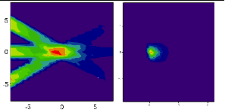
Endoscopic Radiation Revolutionizes Cancer Treatment
Argonne National Laboratory
Contact ANL About This Technology
Conventional X-ray radiation and electron beam therapy: a comparison
Left: Conventional treatment depositing energy into tissue as a function of distance for three 250-kV X-ray beams; Right: Electron beam treatment depositing energy into tissue for a 3-MeV electron beam as a function of distance, with the zero point starting at the end of the laparoscopic tube (note length scale change).
Typically, cancer patients who require radiation therapy may experience an array of side effects, such as nausea, diarrhea, fatigue, or changes in the skin. In addition, the x-ray treatment is linked to secondary cancers. Recently misaligned x-ray treatment systems have caused illnesses—and even death. This groundbreaking innovation in radiation therapy provides successful, cost-effective radiation without the limitations of conventional treatment. The innovation, an endoscopic electron beam, promises to transform the delivery of radiation treatment for millions of cancer patients—including many for whom radiation was previously impossible.
DescriptionRadiation has proven an effective therapy in cancer treatment. However, because human tissue absorbs the electrons, physicians must limit patients’ exposure to radiation and generally prescribe such treatment only for surface cancers or procedures that require large surgical incisions to expose the body core.
Researchers at Argonne National Laboratory, led by John Noonan, have devised an innovative radiation treatment that capitalizes on the benefits of conventional radiation therapy while overcoming its drawbacks. Transporting the electron beam to the internal cancer, the beam can be absorbed by the tumor only, with healthy tissue minimally damaged.
An electron beam, less than 1 millimeter in diameter and at very low beam emittance, is delivered through a laparoscopic tube inserted through a small incision and positioned directly at the tumor. The beam can vary in energy from 1 million to 10 million electron volts, suitable to cover tumors ranging from approximately 0.5 cm to 5 cm, respectively. Enormous doses of radiation can be delivered endoscopically without fear of exceeding advisable total body dose exposure.
The endoscopic method will be highly effective in treating a number of cancers previously regarded as inoperable or in radiation-sensitive areas, such as the spine, nerves, the optic nerve, and organs, including the brain.
Being able to vary the beam’s energy level gives physicians control in preventing damage to healthy tissue. In the case of brain tumors, the laparoscopic tube provides an additional advantage during therapy, as a means of removing dead cells that could harm healthy ones. In addition, because of the technology’s precision, treatment time is shortened, with electron beams potentially requiring only a single treatment as compared with conventional radiation therapy requiring several months—a significant improvement in patient care.
Benefits- Allows effective new treatments for cancers in radiation-sensitive locations and those previously considered inoperable
- Enables the delivery of high doses of radiation to a precisely controlled location without exceeding total body dosage exposure
- Laparoscopic tube permits post-treatment removal of dead cells that could be harmful to healthy tissue
- Potentially, therapy can consist of a one-time treatment compared with months of conventional radiation therapy
- Compact device fits easily in a surgical suite, often under the operating table
- Medicine
ID Number |
Title and Abstract | Primary Lab |
Date |
|---|---|---|---|
Patent 7,312,461 |
Laparoscopic tumor therapy using high energy electron irradiation
A laparoscopic tumor therapy method and an articulated electron beam transport system are provided for use with a high power, long focus electron source for tumor therapy. The high power, long focus electron source generates an e-beam. The e-beam is transported through a laparoscopic tube proximate a target tumor for electron irradiation therapy. |
Argonne National Laboratory | 12/25/2007
Issued |
Development Stage | Availability | Published | Last Updated |
|---|---|---|---|
| Development | Available | 02/07/2012 | 02/07/2012 |


